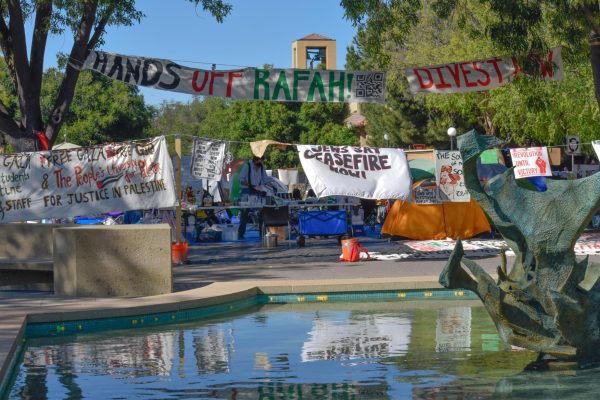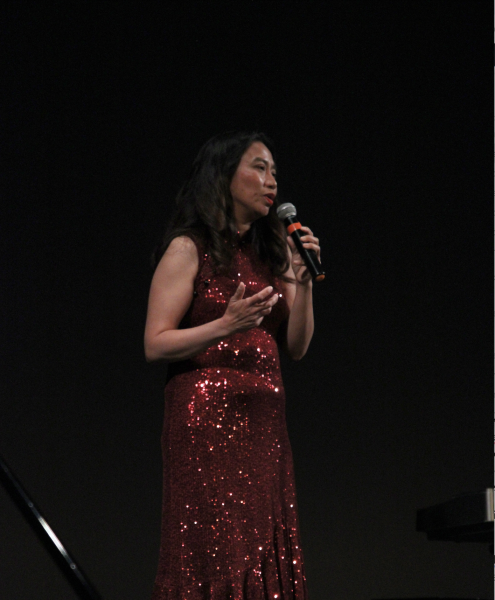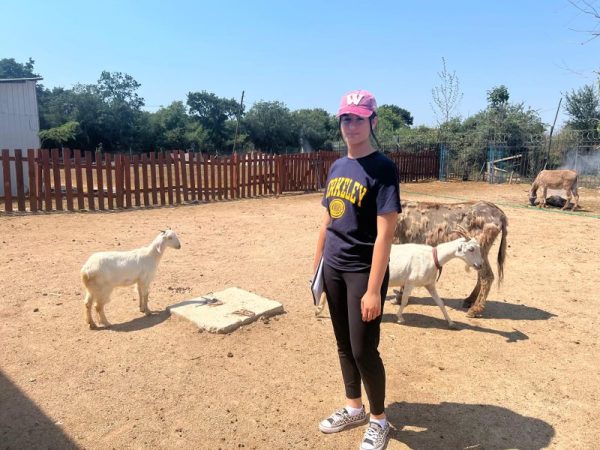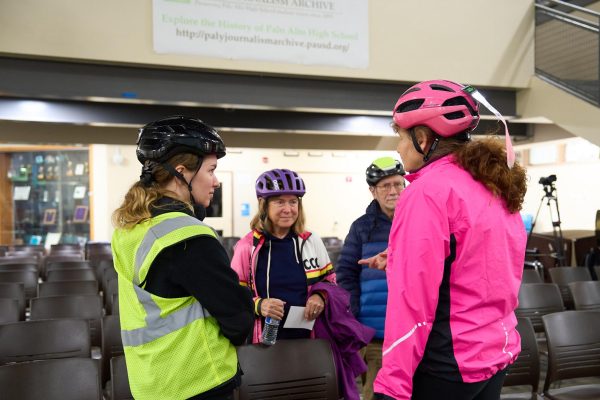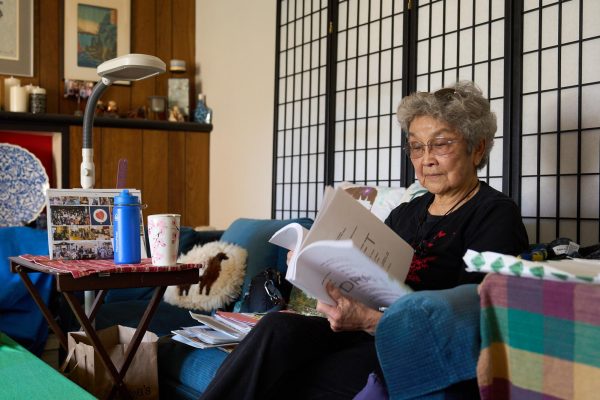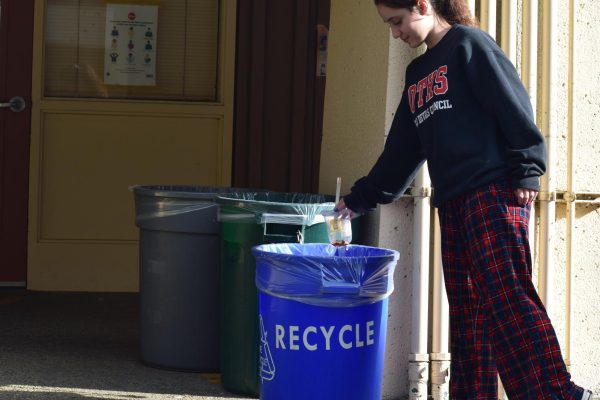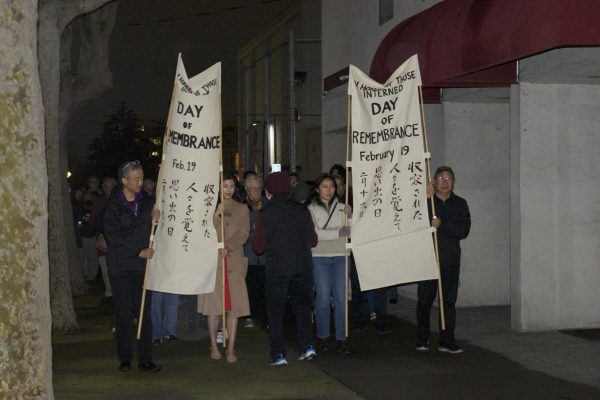Socially Distant Protesting
Innovative ways students protest during a pandemic.
“Fund the USPS,” “Save our postal service,” and “Louis Dejoy brings us woe” were just some of the signs displayed at a USPS protest in Palo Alto in late August. Activist group Raging Grannies and people of all ages gathered together in front of the downtown post office, scrambling to find ways to attract attention from passing bystanders. Then, in came something unexpected: a giant blue inflatable dragon dressed up as a mailman, with mail-in hand and a mask, of course. As he arrived, everyone’s eyes followed the life-sized blue object. An inflatable dragon lured people who initially were not interested to join the crowd and discover what the protest was all about.
Many plans were disrupted and changed because of the COVID- 19 pandemic. However, in some ways, going to a protest was one of the most normal experiences we’ve had lately. People gathered with their signs in solidarity. Cars honked. People with megaphones made speeches.
But on closer inspection, the scene was not the same as one might imagine. People were wearing masks to protect from both the Coronavirus and the smoke. They weren’t congregating like sardines. It’s obvious they were aware of the social distancing guidelines advised by the Centers for Disease Control and Prevention. There was no group chanting — for fear of inhaling too much smoke and spreading droplets. And then there was the dragon.
In-person protesting across the globe
All around the world, people are bringing their own versions of the inflatable dragon to their protests. From New York to Singapore, people have clapped from their windows and balconies to show support for essential workers. In Italy, musicians played “Bella Ciao” from their balconies while others clapped along, as seen in this YouTube video. According to a Guardian article, Brazilians made noise while quarantined in a protest against their president. Everything is used from pots and pans to their own voices to show their disapproval.
As a result of the rising concern over the transmission of the Coronavirus, many are turning to social media for alternative forms of protest that do not require in-person contact. Many times, social media has made it easier to start up or get involved in an organization. Anthro found three students engaged in such projects. Here are their stories:
Live 4 The Earth

Aliya Icasiano, a senior at Mountain View High School, started the @Live4TheEarth Instagram account, providing sustainable living resources and advocating for environmental issues. In her junior year, Icasiano took the AP Environmental Science class at her high school but did not feel satisfied leaving without doing something with her newfound knowledge.
Around the same time that the Black Live Matters movement was taking off, Icasiano became inspired by other creators who were posting information that many did not learn in school. Her inspiration compelled her to start her own account.
“My first post was [about] how to be sustainable during this time because there’s honestly so much waste being created because of this virus,” Icasiano said.
The Live 4 The Earth account is completely run by Icasiano. She recognizes environmental sustainability problems in her everyday life, writes a note in her Notes app on her phone, and later delves into the issue by conducting research. Then, she starts creating the post by doodling on her iPad, so the information is more enjoyable to read and digest.
“I like it because it [the post creating process] forces me to keep educating myself,” Icasiano said.
Icasiano also reposts other creators on the Instagram platform that advocate for environmental sustainability. Icasiano realizes the difficulties of being 100 percent sustainable, but she urges that if everyone contributes in even the smallest ways, we will have a large impact.
Baking for Justice

In mid-June, Winter Pickett, Halo Lynch, and Sabrina Chan, seniors at Palo Alto High School, thought of the idea of selling cupcakes to support the Black Lives Matter movement. They call their effort “Baking for Justice” a cupcake-selling business delivering to Palo Alto and Menlo Park with 100% of their proceeds going towards donations to the BLM movement.*
“Our activism originated from the fact that COVID made it difficult to attend in-person protests and rallies for BLM,” Pickett said.
According to Pickett, she is in the high-risk category for contracting the virus, so she has been unable to attend protests. Many other students who are at a higher risk for contracting coronavirus may share her same desire to help out but don’t have the ability to do so by attending in-person protests.
“I still wanted to contribute to the movement but in a COVID safe manner for myself and my team,” Pickett said.
The BFJ team consisted of Pickett, Lynch, and Chan. Pickett was the founder and baker of the business. Her job was to bake and package all orders, manage email communications, and oversee deliveries. Chan was the operations manager and she updated the BFJ website, managed their finances, and put all of their incoming orders into their system. Lynch was the delivery driver and ensured that customers received their orders in a timely and professional manner.
Pickett said that her team encountered a large amount of trial and error, but she’s glad to have had this experience and to have learned from it. Baking for Justice managed to raise $4600 for the BLM Movement, Pickett said. On September 15, BFJ reported to their Instagram that they raised $4804 in total and donated $1500 to each organization (Bail Project, DREAM, Act Blue).
“Personally, I learned that trying to make an impact takes persistence,” Pickett said.
*Baking For Justice has since closed and is not currently operational as of September 16.
Reclaim Our Vote

Reclaim Our Vote
With the presidential election coming up, many people are doing what they can to motivate others to vote despite the current pandemic.
While working with the organization Reclaim Our Vote, Johannah Seah, a sophomore at Palo Alto High School, has been sending postcards all over the country to reach out to those who have been purged from the voter registry and notify them to reregister. ROV provides students a chance to help with voter turnout and voter suppression.
Seah started when her debate coach presented her with an opportunity to help with post-carding as part of ROV. She started post-carding in late April, encouraging her friends to get involved.
“Once I started post-carding, the word spread, and [had] grown to over 50 people and reached the 20,000 postcard mark,” Seah said.
ROV provides their volunteers with postcards, addresses, and information to write. Seah explained that the organization looks at individuals who have been purged of the registry, so that she and other volunteers can write to them and notify them to register.
Instead of being deterred by the challenges that the pandemic presented, Seah said that the pandemic encouraged her to be more involved in her activism.
“Even during such a dark time, so many of us were able to rise up and work towards something bigger,” Seah said. “I learned so much more about voter suppression and voting barriers, how people are fighting it, and about resilience and the impact of people who are passionate and willing to make a difference.”







